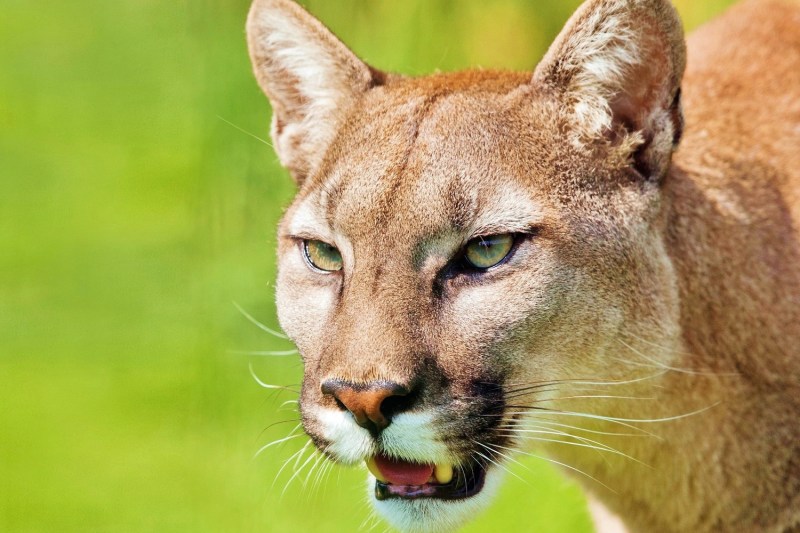
From rabid animals to meat-eating plants to getting lost in the dreaded Alaska Triangle, there are plenty of ways to die in nature. But do we need to worry about mountain lion attacks? The news seems to think so. Fatalities are rare, but they do happen. Although that last deadly encounter — one of the few in recent memory — happened over five years ago. A runner was attacked in Colorado; that story ended favorably for him (but not for the lion) when he managed to kill it with his bare hands.
In fact, experts say we shouldn’t really worry about mountain lions (aka cougars or pumas, depending on where you are in the world). “[Mountain] lion attacks on people are rare, with fewer than a dozen fatalities in North America in more than 100 years,” says Travis Duncan, public information officer for Colorado Parks and Wildlife. In comparison, over 42,000 people were killed on U.S. roadways in 2022.
Mountain lions sound a bit scary, like something we might need Chuck Norris around to keep us safe from. But most of the time, they’re just trying to get away from us. So how do you avoid ever running into one? We talked to the experts to find out how to never see a mountain lion and what to do if you hear mountain lion sounds.

How to prevent a mountain lion encounter (before it ever becomes an attack)
Prevention is key with mountain lions. If you do it right while camping, hiking, or mountain biking your favorite trails, you probably will never see one. But, the question, of course, is: How do we do it right?
“I would say that encountering pumas in the wild should be considered a good thing, but for those who want to avoid pumas, they should avoid activity in puma habitats, especially things like running which may trigger predation instinct, and particularly in morning and evening when pumas are more active,” says Dr. John Goodrich, Chief Scientist and Tiger Program Senior Director for Panthera, the global wild cat conservation organization
Being noisy might be the exact opposite of what some of us want to do when enjoying the pristine wilderness. But, like preventing bear attacks, it’s likely the best way to avoid rounding the corner and scaring a mountain lion. Ever feel like punching someone in the face when they scare the daylights out of you? Right. It’s kind of like that but with more teeth and claws.
Richard Beausoleil, Bear and Cougar Specialist for the Washington Department of Fish & Wildlife, advises, “If you are an outdoor enthusiast, you need to let wildlife know you are coming so they can avoid you. Trails with sharp turns are the most crucial but I recommend all outdoor enthusiasts carry a $2 whistle and/or use a horn. If you blow the whistle every few minutes on a bike (and at every corner) you will avoid a surprise encounter with wildlife.”
If you can, travel with multiple people. “Bike, hike, and ski in groups,” Duncan elaborates. “Run with a buddy. Do not run alone in lion habitat.” It really is that simple.

How to survive a mountain lion attack (when prevention fails)
Again, chances are you’ll never see a mountain lion. But what should you do if it happens (besides buying a lottery ticket right after)?
Mountain lions won’t attack prey that’s too big. Be that giant monster they decide against approaching.
“Talk calmly yet firmly to it and make enough eye contact so that it knows you have seen it. Slowly back away. Do not run.”
“You need to stop immediately, use the whistle, and clap your hands loudly (which sounds like a gunshot). Don’t clap like an applause — simply make a sharp, loud noise and repeat. Then, raise your hands and be as loud as possible,” says Beausoleil.
Duncan adds, “Stay calm. Talk calmly yet firmly to it and make enough eye contact so that it knows you have seen it. Slowly back away. Do not run. Running may stimulate a lion’s instinct to chase and attack. Face the lion and stand upright.” Do your best to look like predator, not prey.
“If the lion behaves aggressively, throw stones, branches, or whatever you can get your hands on without crouching down or turning your back,” urges Duncan.

Gear to help you survive a mountain lion attack
We can’t overstate the fact that mountain lions almost never attack humans. But, if you’re forced to defend yourself, the best option (aside from a rifle, of course) is good ol’ fashioned bear deterrent spray. These hyper-concentrated pepper spray formulas are designed to fend off bears, so they work on pretty much any land predator.
Mountain lions are extremely fast, capable of sprinting up to 50 miles per hour. So, you need a spray with a long effective range: 25 feet minimum, but 30-35 feet is better. It goes without saying that you never want your first time deploying a spray to be during an attack, so practice using your bear spray before it ever gets to that point.
Remember these tips, and you’ll (probably) never need to call Chuck Norris for help with a mountain lion.


